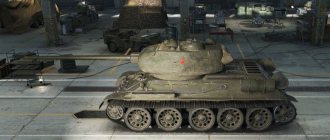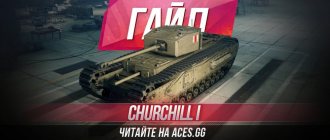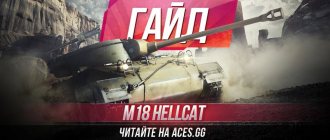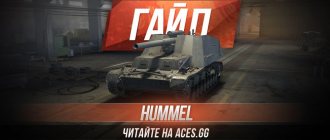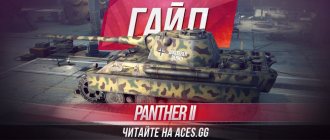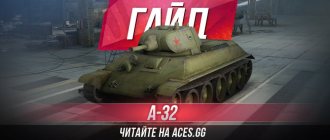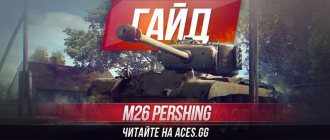Hello everyone and welcome to aces.gg! Now we will talk about a car that has been in the hangar of a huge number of players, because this is a Soviet heavy tank of the sixth level, in front of you is the KV-85 guide
.
the KV-85 has
, without knowing which it will be extremely uncomfortable and even difficult to play, so let’s move on to analyzing the parameters of our heavyweight.
Leveling up
- First of all, we are studying the top-end chassis KV-122, which will add maneuverability, cross-country ability and allow the installation of a top-end turret.
- Let's explore the KV-122 turret mod. 1944 This will add 20 review points to us.
- Next we study the top 122 mm D2-5T gun. The gun has a unique alpha of 390 HP, but takes a long time to assemble and reload;
- The improved V-2IS engine will allow us to quickly deliver the gun to the battlefield;
- Then we will examine the top-end radio 10RK and get the maximum communication range for the KV-85 of 440 m;
- To switch to the heavy tanks branch, you need to study the IS for 49,480 experience;
- To switch to the medium tank branch, you need to study the KV-13 for 53,300 experience.
Equipment, gear and ammunition:
List of equipment that can be installed on the KV-85:
Equipment for the KV-85 tank:
For Active-Action , you need to install the Rammer, Reinforced Aiming Drives, and Coated Optics . On the first slot we install complex Rammer equipment, which increases the reload speed by 10% . On the second slot we install complex equipment: Reinforced aiming drives, which increases the gun aiming speed by 10% . On the last slot we install complex equipment Coated optics, which increases the viewing range by +10% .
For the Universal you need to install the equipment “Rammer”, “Reinforced aiming drives” and “Improved ventilation” . On the first slot we install complex Rammer equipment, which increases the reload speed by 10% . On the second slot we install complex equipment: Reinforced aiming drives, which increases the gun aiming speed by 10% . In the last slot we install complex equipment Improved ventilation, which increases the level of proficiency in the main specialty and additional skills by 5% .
Equipment:
List of equipment that can be installed on the KV-85:
The equipment should be equipped with a standard set of equipment: Small repair kit , Small first aid kit , Hand fire extinguisher . The fire extinguisher can be replaced with Lend-Lease oil , which will increase engine power by 5% . For tournaments or when there are a lot of credits, you can replace the fire extinguisher with Extra Ration 10% to all skills .
Ammunition:
For the 100 mm S-34 , we’ll take most of the armor-piercing shells, but against more armored opponents it’s worth taking a few premium sub-caliber shells, which will make the game easier. High-explosive fragmentation shells will be useful for us to shoot down the capture of the base and finish off opponents with a small margin of safety. The total ammunition load is 41
projectile
Assembly of equipment, equipment and ammunition - Active actions:
| 28 | 10 | 3 | ||||||
Assembly of equipment, consumables and ammunition - Universal:
| 28 | 10 | 3 | ||||||
Review
The KV-85 is a second-line tank, a support tank. With its 122 mm cannon it is capable of crushing opponents at medium and close ranges. It is not recommended to shoot at a long distance due to low accuracy.
In open areas, the KV-85 does not last long due to its general cardboard nature and long reload time. It is necessary to use shelters in the form of embankments, stones, houses. It is better to stay close to allies who can cover you if something happens.
The whole essence of the gameplay on the KV-85: shot and rolled away, shot and rolled away, shot and rolled away, etc. The KV-85 feels comfortable on city maps and in corridors. It is more difficult to play on rough terrain due to the fact that the gun practically does not tilt downwards.
Main characteristics
Let's consider all the main performance characteristics of the tank, namely armor, mobility and firepower.
Tank armor
The strongest part of the tank is the turret forehead; it is 100 mm thick. Like most Soviet tanks, the turret has a rounded shape, which increases the possibility of ricochets and cases of failure to penetrate the armor provided. Of course, this applies mainly to vehicles of level VI and lower; for high-level vehicles such a tower will not be a problem, but at least there is some kind of protection.
As for the hull, things are worse here: 75 mm in the forehead and 60 mm in the sides. This is only enough against very weak guns of low levels. You can “diamond” on a tank, but not against levels seven and eight.
Armament
The main weapon of the tank is the 100 mm S-34 cannon. One-time damage is 250 units, penetration is 170 mm, reload time is 7.6 seconds. The gun has good accuracy, but its aiming speed leaves much to be desired. Overall, this is a pretty good weapon for its level, allowing you to fight enemy tanks normally.
Sometimes players install the D-2-5T cannon, which has an amazing one-time damage of 390 units for its level. In addition, it has slightly higher penetration by armor-piercing and sub-caliber projectiles: 175 mm and 217 mm, respectively. But there is also the other side of the coin: a very long reload, long aiming and simply disgusting accuracy. A long reload leads to the fact that in terms of damage per minute (DPM), the D-2-5T is almost two times inferior to the S-34: 1170 versus 1973 units, respectively.
Mobility
In terms of maximum speed and power density, the KV-85 is practically no different from other Soviet heavy aircraft of this level. But due to the higher turning speed of the chassis, it is quite significantly superior to them in terms of dynamics.
Armament
| 85 mm D-5T gun in the KV-85 turret | 100 mm S-34 gun in the KV-122 mod turret. 1944 | 122 mm D2-5T gun in the KV-122 mod turret. 1944 |
Advantages and disadvantages
In order to fully understand the chosen tank and learn how to play it, you need to have a good knowledge of at least its main strengths and weaknesses. Now we will analyze these nuances point by point, but we will talk about the KV-85 World of Tanks
with a 100 mm caliber gun. Pros: • Not a bad alpha strike; • Good damage per minute; • Decent armor penetration parameters; • Good mobility (dynamics, maximum speed, maneuverability). Cons: • Weak armor; • Very poor visibility; • Mediocre accuracy; • Terrible elevation angles.
Specifications
Stock equipment
Basic Balance weight: 21.6 Price: 900,000 kr Durability: 820 HP View: 320 m. Communication: 325 m.
Armament Ammunition: 70 pcs. Damage: 160 / 160 / 280 HP Penetration: 120 / 161 / 43 mm. Reload: 4.9 sec. Accuracy: 0.38 Aiming time: 2.9 GN speed: 28 °/s VN angles: -2.8…+23°
Reservation Case: 75 / 60 / 60 mm. Tower: 100 / 90 / 90 mm.
Mobility Power: 500 hp Speed: 34 / 14 km/h. Agility: 28 °/s Ground resistance: 1.1 / 1.3 / 2.3
Top equipment
Basic Balance weight: 21.6 Price: 900,000 kr Durability: 870 HP View: 340 m. Communications: 440 m.
Armament Ammunition: 28 pcs. Damage: 390 / 390 / 465 HP Penetration: 175 / 217 / 61 mm. Cooldown: 20 sec. Accuracy: 0.5 Aiming time: 3.6 GN speed: 28 °/s VN angles: -3…+20°
Reservation Case: 75 / 60 / 60 mm. Tower: 100 / 90 / 90 mm.
Mobility Power: 600 hp Speed: 34 / 14 km/h. Agility: 30 °/s Ground resistance: 1 / 1.1 / 2.1
Historical reference
KV-85 (Object 239) is a Soviet heavy tank during the Great Patriotic War. The abbreviation KV means “Klim Voroshilov” - the official name of serial Soviet heavy tanks produced in 1940-1943. Index 85 indicates the caliber of the vehicle's main armament.
The KV-85 was developed in May-July 1943 in connection with the appearance of new heavy Tiger tanks by the enemy. The tank was put into service on August 8, 1943 and was mass-produced at the Chelyabinsk Kirov Plant (ChKZ) until October of the same year inclusive. The reason for discontinuation was the transition of ChKZ to the production of a more advanced heavy tank IS-1.
A total of 148 KV-85 tanks were built, which were actively used in combat operations in 1944. All vehicles sent to the front were irretrievably lost or written off in 1944-1945. To this day, only one authentic KV-85 and one earlier experimental tank “Object 238” (KV-85G) have survived.
Heavy tank KV-85
KV-85 is a Soviet serial heavy tank from the Second World War. KV means “Klim Voroshilov” - the official name of Soviet serial heavy tanks produced in 1940-1943. Index 85 is the caliber of the main armament of the tank. This tank was developed in May-July 1943 by the design bureau of experimental plant No. 100. The main reason for the start of work on the combat vehicle was the appearance of a new heavy Tiger tank by the enemy. The KV-85 tank was adopted by the Red Army on August 8, 1943 and was mass-produced by the Chelyabinsk Kirov Plant until October 1943. The tank was discontinued due to the transition of ChKZ to the production of more advanced IS-1 heavy tanks. In total, 148 KV-85 tanks were built at ChKZ, which were actively used in combat operations in 1944. The tanks sent to the front were lost or written off in 44-45. To this day, only one authentic KV-85 tank and one experimental KV-1s tank have survived, whose standard 76-mm gun was replaced with an 85-mm gun.
History of creation
The appearance of the heavy Tiger tank among the German troops at the end of 1942 - beginning of 1943 overnight made the Soviet heavy tanks KV-1 and KV-1s ("high-speed" modification) obsolete. Impenetrable by German anti-tank and tank guns in 1941 and early 1942, the KV armor for the Tiger gun did not pose any particular difficulty. At the same time, the 76-mm ZiS-5 cannon mounted on the KV could only penetrate the rear and side armor of the Tiger at a range of no more than 200 meters. Under these conditions, work was accelerated on the development of new types of artillery weapons and the IS heavy tank for the Red Army, which would be able to penetrate the armor of the Tigers. Based on the results of the shelling of the Tiger, which fell into the hands of Soviet designers, it turned out that its frontal armor at a distance of up to 1 thousand meters is penetrated by shells from an 85-mm anti-aircraft gun mod. 1939 (52-K). in this regard, on May 5, 1943, at a meeting of the GKO (State Defense Committee), resolution No. 3289 “On strengthening art. armament of self-propelled guns and tanks." In this decree, artillery and tank designers were tasked with developing self-propelled and tank 85-mm guns with anti-aircraft ballistics. It was assumed that these guns would be installed in the standard KV-1s turret and also on the new IS tank.
TsAKB (Central Artillery Design Bureau), headed by V.G., was appointed responsible for this task. Grabin and design bureau of artillery plant No. 9, head F.F. Petrov. These teams tried to put their design into service, and their heads many times sent letters to higher authorities containing accusations against “competitors”, as well as answers to certain technical or organizational questions. Despite this, by June 14, 1943, both teams presented their guns for installation on experimental tanks. TsAKB developed the 85-mm S-31 gun on the basis of the 76-mm ZiS-5 tank gun. This was done by placing an 85-mm barrel group on the cradle of a serial cannon. The design bureau of plant No. 9 used the design of its 85-mm self-propelled gun D-5S, the lifting mechanism and bolt of which were taken from the serial 76-mm F-34 tank gun.
By 20.07. In 1943, experimental plant No. 100 assembled two experimental KVs armed with these guns. The first was the Object 238, also called the KV-85G. This vehicle fully complied with the specifications - the KV-1s with a standard 1535 mm turret had a 76 mm ZiS-5 gun replaced with an 85 mm S-31 gun developed at TsAKB. The second experimental tank, the KV-85 (“Object 239”), was built on its own initiative by designers of the Chelyabinsk Kirov Plant and Plant No. 100 under the leadership of Zh.Ya. Kotina. Since only the turret from the IS tank was available (the hull was not yet ready), it was installed on the KV-1s chassis. At the same time, the diameter of the lower shoulder strap of the fighting compartment roof was increased from 1535 millimeters to 1800 millimeters. This operation was technically difficult, since the diameter of the shoulder strap was greater than the width of the roof of the fighting compartment. The solution was to expand the turret box by welding cylindrical armor inserts under the protruding parts of the shoulder straps. Since there was no second S-31 to arm the Object 239, it was equipped with an 85-mm D-5T cannon developed in the design bureau of plant No. 9. The KV-85, along with a couple of prototypes of the IS tank, passed factory tests, the KV-85G in them did not participate - it was clear that it would not pass due to the tightness of the fighting compartment. During testing, the KV-85 traveled 284.5 kilometers at an average speed of 16.4 km/h. Since the Red Army was in great need of new tanks, these tests were counted as state tests. On August 8, the State Defense Committee, even before the end of the tests, adopted Resolution No. 3891 on the adoption of the KV-85 for service and the start of their serial production at ChKZ. The first production KV-85s left the plant’s assembly lines a few days later.
The D-5T cannon also demonstrated its advantages over the S-31 during testing at the Gorokhovets artillery range from August 21 to 24. All four experimental tanks - KV-85, KV-85G and two IS prototypes - took part in these tests. The D-5T vibrated less after being fired, did not have bulky balancing weights, was smaller in size, and was easy to maintain and durable. However, this had to be paid for by using in its design a large number of small parts with high requirements for their machining and tolerances. As a result, the D-5T gun was produced in small series, which did not allow the installation of this weapon on all new T-34-85 medium tanks. Therefore, for the new vehicles it was necessary to develop a new, more technologically advanced 85-mm ZiS-S-53 cannon with identical ballistics.
Production
The first production KV-85 was built at pilot plant No. 100, and the remaining 147 vehicles were built by ChKZ. To build the first vehicles, they used the backlog of armored hulls for KV-1s tanks, which is why it was necessary to weld holes for the ball mounting of the course machine gun and make cutouts in the turret box for the extended turret ring. The necessary changes were made to the design of the armored hull of subsequent series of vehicles. The KV-85 tank was in production at ChKZ for three months, from August to October 1943. In August, 22 vehicles were built, in September and October - 63 each. Small volumes of deliveries of 85-mm D-5T guns, as well as a large the need for them to arm the T-34-85 and IS-1 tanks was the reason that in August the KV-85s were produced in parallel with the KV-1s tanks. In November 1943, the highest priority was given to the production of IS tanks, and the KV-85 tanks were completely discontinued.
Description of design
At its core, the KV-85 was a transitional model between the KV-1s and IS-1 tanks. The KV-85 heavy tank borrowed most of the armored hull parts and the entire chassis from the KV-1s, and the turret and gun from the IS-1. The changes concerned only the armored parts of the turret box - for the KV-85 they were made anew to install a new larger turret with a shoulder strap of 1800 millimeters. The tank had a classic layout, the same as all other serial Soviet medium and heavy tanks of that time. The armored hull housed sequentially from bow to stern: the control compartment, the combat compartment and the engine-transmission compartment. The control compartment housed the driver, the jobs of the other three crew members were in the fighting compartment, which combined the turret and the middle part of the armored hull. The same compartment housed the gun, ammunition, and part of the fuel tanks. The transmission and engine were installed in the rear of the tank.
Electrical equipment
In the KV-85, the electrical wiring was single-wire, the armored hull of the tank served as the second wire. The exception was the emergency lighting circuit, made according to a two-wire circuit. The sources of electricity with an operating voltage of 24 V were the GT-4563A generator with a RPA-24 relay-regulator (power 1 kW) as well as four series-connected 6-STE-128 batteries (total capacity 256 Ah). Electricity consumers were: electric motor for turning the tower; internal and external lighting of the vehicle, illumination of scales of measuring instruments and sights; alarm circuit from the landing party to the tank crew and an external sound signal; instrumentation (voltmeter and ammeter); electric trigger of the gun; tank intercom and radio station; electrics for the motor group, which included an ST-700 starter, RS-400 or RS-371 starting relays, and so on.
Sights and surveillance equipment
The loader's workplace and the commander's hatch were equipped with MK-4 periscope devices, allowing observation of the surrounding environment from inside the vehicle (2 pieces in total). The commander's cupola had five viewing slits covered with protective glass. During the battle, the driver conducted observation using a viewing device with a triplex glass protected by an armored flap. This viewing device was installed in an armored hatch-plug located on the frontal armor plate along the longitudinal center line of the tank. This hatch-plug moved forward in a calm environment, giving a convenient direct view from the driver’s workplace.
The KV-85 tank was equipped with two gun sights - the periscope PT4-15 (for firing from closed positions) and the telescopic 10T-15 (used for direct fire). The head of the periscope sight was protected by a special armored cap. The sight scales were equipped with illumination devices, which made it possible to fire in the dark. The stern DT machine gun was equipped with a four-fold PU sight from a sniper rifle.
Means of communication
The communications equipment of the KV-85 tank was the 9R radio station (or 10R, 10RK-26), as well as the TPU-4-Bis intercom, designed for four subscribers.
The radio station 10Р (10РК) was a set consisting of a transmitter, receiver and umformers (single-armature motor-generator) for their power supply, which were connected to the on-board electrical network.
10P was a simplex tube heterodyne shortwave radio station operating in the range of 3.75-6 MHz (wavelengths 50-80 meters). The communication range in voice (telephone) mode in a parking lot reached 25 km; while driving, it decreased somewhat. A long communication range could be obtained in telegraph mode, when transmitting information using a telegraph key using Morse code or another discrete coding system. Frequency stabilization was carried out using a removable quartz resonator. There was no smooth adjustment. The 10P radio provided communication on a pair of fixed frequencies; To change frequencies, another quartz resonator was used, consisting of 15 pairs included in the radio set.
10RK was a technological improvement of the 10R radio station. The new radio station was simpler and cheaper to produce. The 10RK now has the ability to smoothly switch operating frequencies; the number of quartz resonators has been reduced to 16. The communication range has not changed significantly.
The TPU-4-Bis tank intercom made it possible to negotiate among crew members even in very noisy conditions and to connect a headset (laryngophones and headphones) to the radio station for external communication.
Engine
The KV-85 tanks were equipped with a V-shaped four-stroke 12-cylinder diesel engine V-2K with a power of 441 kW (600 hp). The engine was started by an ST-700 starter with a power of 11 kW (15 hp) or compressed air which was in two tanks with a capacity of 5 liters located in the fighting compartment. The layout of the KV-85 was dense, with the main fuel tanks (capacity 600-615 liters) located not only in the engine and transmission compartment, but also in the fighting compartment. The tank was also equipped with four additional external fuel tanks (total capacity 360 liters) which were not connected to the engine fuel system.
Transmission
The tank had a mechanical transmission consisting of: a multi-disc main dry friction clutch (“steel on ferodo”); four-speed gearbox with a range multiplier (8 forward and 2 reverse gears); two multi-disc side clutches (“steel on steel”); two onboard planetary gearboxes. Transmission control drives are mechanical.
Chassis
The KV-85 chassis was completely identical to the KV-1s chassis. The suspension is individual torsion bar for each of the 6 gable solid road wheels (diameter 600 mm) on each side. Travel limiters for the suspension balancers were welded to the armored body opposite the road wheels. The drive wheel, which has a removable pinion gear, was installed at the rear. The sloths were located in front. The upper branch of the caterpillar was supported by three (on each side) small solid-cast support rollers. The caterpillar tension mechanism is screw. The caterpillar consisted of 86-90 single-ridge tracks. The track width is 608 millimeters.
Armament
The main armament of the KV-85 tank was the 85-mm D-5T cannon. The gun was mounted in the turret on axles and was balanced. The turret with the D-5T cannon was also balanced: the center of mass was on the geometric axis of rotation. The vertical pointing angles of the D-5T gun ranged from −5° to +25°. When the tower was in a fixed position, the gun could be aimed in a horizontal plane in a small sector (the so-called “jewelry” aiming). The shot was fired using a manual mechanical trigger or an electric trigger.
The gun's ammunition consisted of 70 unitary loading shots, which were placed along the sides of the fighting compartment and in the turret. Compared to the “assortment” of ammunition for the 85-mm 52-K anti-aircraft gun, the KV-85’s ammunition load was less varied. The ammunition included: an armor-piercing unitary shot (weight 16 kg) with an armor-piercing tracer blunt-headed projectile, with a BR-365 ballistic tip (tip weight - 9.2 kg, explosive - ammotol or TNT - 164 g) and a G-365 charge ( weight from 2.48 to 2.6 kg). Initial speed - 792 meters per second; armor-piercing unitary shot (weight 16 kg) having an armor-piercing tracer sharp-headed projectile BR-365K (projectile weight 9.2 kg, explosive - ammotol or TNT - 48 g) and a G-365 charge (weight from 2.48 to 2.6 kg). Initial speed - 792 meters per second; armor-piercing unitary shot (weight 11.42 kg) having a BR-365P coil-type sub-caliber projectile (weight 5.0 kg) and a G-365 charge (weight from 2.5 to 2.85 kg). Initial speed 1050 meters per second; fragmentation unitary shot (weight 14.95 kg) having an O-365 projectile (weight 9.54 kg, explosive mass - ammotol or TNT - 741 g) and a G-365 charge (weight 2.6 kg). Initial speed - 792 meters per second.
O-365 fragmentation shells had a large number of options. If equipped with some fuses, they could be used as high-explosive fuses.
According to Soviet data, an armor-piercing projectile BR-365 at an impact angle of 90 degrees. an 111-mm armor plate was pierced at a distance of 500 meters; at a distance of 1000 meters, under the same conditions, an armor plate 102 millimeters thick was pierced. A BR-365P sub-caliber projectile normally penetrated an armor plate 140 millimeters thick at a distance of 500 meters. At an impact angle of 30° relative to the normal, the BR-365 projectile, when fired at point-blank range, penetrated armor 98 millimeters thick, and at a distance from 600 to 1000 meters - 83-88 millimeters.
The KV-85 was equipped with three DT machine guns of 7.62 mm caliber: coaxial with the gun, fixed in the directional direction and aft in the rear of the turret in a ball mount. The ammunition for the DT machine guns consisted of 3276 rounds. These machine guns were installed in such a way that, if necessary, they could be removed and used outside the vehicle. In addition, the crew had F-1 hand grenades for self-defense, and sometimes crew members were equipped with a pistol for firing a flare.
The first copy of the KV-85 after shelling tests. Chelyabinsk. Autumn 1943
Turret and armored body
The armored hull of the KV-85 tank was welded from rolled armor plates with a thickness of 20, 30, 40, 60 and 75 millimeters. Armor protection against projectiles, differentiated. The armor plates of the frontal part of the tank were installed at rational angles. The streamlined turret is an armor casting of complex geometric shape. The thickness of the side armor was 100 millimeters; it was located at an angle to increase projectile resistance. The front part of the tower with the embrasure was formed by the intersection of four spheres and was cast separately. It was connected to the rest of the armored parts by welding. The gun mantlet was a cylindrical segment of a rolled bent armor plate, which had three holes - for a cannon, a sight and a coaxial machine gun. The turret was mounted on a shoulder strap (diameter 1800 millimeters) in the armored roof of the fighting compartment. For fixation, grips were used that prevented stalling when the tank overturned or rolled strongly. The “contact” surface of the upper shoulder strap of the armored hull and the lower shoulder strap of the turret was recessed into the roof of the fighting compartment. This prevented the turret from jamming during shelling. The turret ring for firing from closed positions was marked in thousandths.
The driver was located in the front of the tank hull in the center. Since the installation of a larger turret did not allow the gunner-radio operator to be placed in the control compartment, he was completely excluded from the crew. The hole made in the frontal part for the ball mounting of the course machine gun was welded, and the machine gun itself was placed in a fixed mount to the right of the driver. Indirect fire from this machine gun was conducted by the driver, pressing the trigger of the electric trigger mechanism located on the control lever. This design solution was used on subsequent Soviet heavy IS tanks, but later frontal machine guns were completely abandoned due to the low effectiveness of non-aimed fire, as well as weakened frontal armor. Three crew members were located in the turret: the tank commander and gunner's positions were to the left of the gun, and the loader's was to the right. The commander had an observation turret made of casting with an armor thickness of up to 82 millimeters. For entry/exit of the crew, hatches in the turret were used: a double-leaf round hatch for the commander's cupola, a single-leaf round hatch for the loader. The hull had a bottom hatch used for emergency escape from the tank and several hatches, technological holes and hatches for loading ammunition, access to the units and components of the vehicle, and fuel tank necks.
Vehicles based on the KV-85
Installing an IS turret on a HF chassis opened up the possibility of mounting more powerful artillery systems on the chassis. For example, at the end of 1943, experimental tanks KV-122 and KV-100 were built. The KV-100 was armed with a 100-mm S-34 cannon, and the KV-122 with a 122-mm D-25T cannon. Since the new IS-2 heavy tank, which has much more advanced armor protection, was being launched into mass production, the question of adopting these vehicles into service with the Red Army did not even arise.
Combat use of the KV-85 tank
Starting in September 1943, KV-85 tanks began to enter service with the OGvTTP. Around the same time, however, with some delay, which was required for the formation of new units, as well as their dispatch to the front, the tanks entered into battle, mainly in the southern directions. Since the KV-85 was inferior in its characteristics to German heavy tanks, and their armor protection was not sufficient for that time, the battles in which the KV-85 participated were fought with varying success, and the result was largely determined by the training of the crews.
Heavy Soviet tank KV-85, knocked out by the Germans with tail number “32”
The main purpose of the KV-85 is to break through pre-fortified enemy defensive lines, where the main danger was anti-tank self-propelled and towed guns, engineering and mine-explosive obstacles, and not enemy tanks. Despite insufficient armor, the KV-85 basically completed its task, but at the cost of significant losses. The small volume of production, as well as the intensive use of KV-85 tanks, became the reason that by the fall of 1944, due to irretrievable combat losses and write-offs, there were no tanks of this type left. There is no information about the combat use of these tanks after this period.
There are several references to the confrontation between the KV-85 and enemy tanks. For example, from November 20 to 23, the Thirty-fourth OGvTTP Twenty-eighth Army of the Fourth Ukrainian Front, consisting of 20 KV-85 tanks with the support of the 9th and SU-152 of the Fortieth OTSAP, attacked German positions near the village of Ekaterinovka. During these battles, the Forty-third OGvTTP lost 8 KV-85 tanks (the result is unknown), destroying 5 German PzKpfw IVs, as well as towed guns and enemy infantry.
However, the KV-85, in the hands of tactically competent and experienced tankers, was a formidable weapon capable of successfully destroying new German armored vehicles. Excerpt from the “Report on the combat operations of the mechanized and armored forces of the Thirty-eighth Army in the period from January 24 to January 31, 1944.” for the Seventh Separate Guards Heavy Tank Regiment (OGTTP) testifies:
“In accordance with the combat order of the headquarters of the Seventeenth Corps, the remaining 5 self-propelled guns and tanks (2 SU-122 and 3 KV-85) by 7.00 on January 28, 1944 were occupied at the state farm named after. Telman all-round defense in readiness to repel an attack of enemy tanks in the direction of Rososh, the Bolshevik state farm, and the Kommunar state farm. Near the tanks, 2 anti-tank guns and 50 infantrymen took up the defense. A concentration of enemy tanks was noted south of Rososh. At 11.30 the enemy, with up to 15 T-6s and 13 small and medium tanks in the direction of Rososh, supported by infantry from the south, attacked the Telman state farm.
Occupying advantageous positions, from behind stacks and buildings, having brought the enemy within direct shot range, our self-propelled guns and tanks opened fire, disrupting the enemy’s battle formations. At the same time, 6 tanks were knocked out (3 of which were Tigers) and destroyed before the infantry platoon. To eliminate the breakthrough of the German infantry, the KV-85 tank was allocated from the group under the command of Art. Lieutenant Kuleshov, who completed the task with tracks and fire. By 13.00 of the same day, enemy troops, not daring to attack the Soviet regiment head-on, bypassed the Telman state farm, completing the encirclement of the Soviet group.
The battle of Soviet tanks surrounded against superior forces is characterized by extreme heroism and skill of our tank crews. The tank group (guard company commander, Senior Lieutenant Podust), defending the Telman state farm, did not allow enemy troops to transfer forces to other areas. The tanks, often changing firing positions, conducted aimed fire at the enemy tanks, and the SU-122s entered open positions, shooting the infantry that was mounted on conveyors and moving along the road to Ilyintsy, blocking the freedom of maneuver of the enemy tanks and infantry. In addition, by their actions they contributed to the exit of units of the Seventeenth Rifle Corps from encirclement. Encircled, the tanks continued to fight until 19.30, although by this time there was no infantry at the state farm. Intense fire, maneuver and use of cover made it possible to suffer almost no losses (except for two wounded), inflicting significant damage to the enemy in equipment and manpower. On January 28, 1944, 5 Tiger tanks, 5 T-4s, 2 T-3 tanks, 7 armored personnel carriers, 6 anti-tank guns, 4 machine gun emplacements, up to three platoons of infantry were destroyed and knocked out. carts with horses - 28.
At 20.00 the group made a breakthrough from the encirclement. After a firefight, the tank group reached the location of the Soviet troops by 22.00. At the same time, 1 SU-122 was lost and burned out.”
According to Polish data, 5 KV-85 tanks were transferred to the People's Army of Poland in 1945, where they were used as training tanks in the early post-war years.
Tactical and technical characteristics of the KV-85 heavy tank:
Combat weight - 46 tons; Crew – 4 people; Case length – 6900 mm; Length – 8490 mm (with gun forward); Case width – 3250 mm; Height – 2830 mm; Ground clearance – 450 mm; The main armament is an 85-mm D-5T cannon; Auxiliary weapons – 3 DT machine guns of 7.62 mm caliber; Ammunition for the main gun – 70 pcs.; Ammunition for auxiliary weapons – 3276 pcs.; Engine brand - V-2K; Engine type – diesel; Engine power – 600 hp; Maximum speed – 42 km/h; Power reserve – 330 km; Specific power – 13 l. s./t; Obstacles to be overcome: Vertical wall – 0.8 m; Ditch – 2.7 m; Fordability – 1.6 m; Lift/roll – 40 degrees.
Based on materials from the site https://3v-soft.clan.su/
